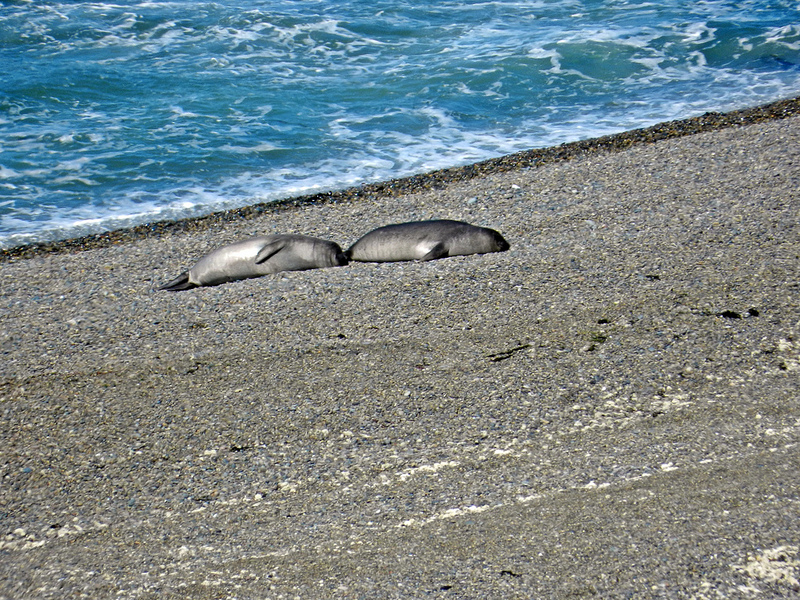Elevated carboxyhemoglobin in a marine mammal, the northern elephant seal, study
15 May, 2014
Elephant seals’ CO as high as heavy human smokers’. By Kathryn Knight. jeb.biologists.org.May 15, 2014.Carbon monoxide (CO) is a silent killer. Produced by incomplete combustion, the colourless, odourless gas binds to the oxygen carrying protein – haemoglobin – in the blood of smokers and fire victims, insidiously clogging the protein to prevent it from transporting oxygen, resulting in suffocation. However, in recent years, CO has undergone something of a rehabilitation. Michael Tift, from the Scripps Institution of Oceanography, USA, explains that we all produce minute quantities of CO naturally and at very low concentrations, the gas has beneficial effects.

Elefantes marinos en la playa
(SerTox)
 Two adult male elephant seals. Photo credit: Michael Tift.
Two adult male elephant seals. Photo credit: Michael Tift.He says, ‘CO reduces inflammatory responses and the amount of apoptosis – cell death – due to heart attack and stroke.’ Knowing that only 1% of human non-smokers’ haemoglobin is incapacitated by CO – in the form of carboxyhaemoglobin – and that CO is produced naturally by haemoglobin breakdown, Tift’s colleagues, Dan Crocker and Paul Ponganis, wondered how much CO an elephant seal might carry in its blood, as they have the largest blood volumes of any animal of their size (p. 1752).
At the time, Tift was working closely with colleagues at the University of California, Santa Cruz, USA – which has been studying elephant seals at the Año Nuevo State Park for 25 years – so he could call on their experience of working with the seals. Mildly sedating animals ranging from young pups to adults, Tift collected blood samples from the elephant seals to measure the proportion of carboxyhaemoglobin in their blood. The team was also curious to find out how the elephant seals’ carboxyhaemoglobin levels altered with age, as the oldest animals have the largest blood volumes and highest levels of haemoglobin.
Measuring the relative proportions of the haemoglobin bound with the oxygen, carbon dioxide and CO in the seals’ blood using a blood gas analyser, Tift was amazed to discover that the animals’ carboxyhaemoglobin levels were stratospherically high at 10.4%; ‘They have values similar to humans that smoke up to 40 cigarettes a day’, says Tift. Next the team compared the carboxyhaemoglobin levels of the youngsters with those of the mature animals and found that the proportion of carboxyhaemoglobin in the blood increased as the animals aged, probably because of the veterans’ higher haemoglobin levels. And when Tift monitored the carboxyhaemoglobin levels of a pair of juveniles over a day, it was clear that the amount of carboxyhaemoglobin in the animals’ blood was incredibly stable.
So why are the seals’ carboxyhaemoglobin levels so high? Tift explains that there is only one way for an animal to clear CO from its body, and that is to exhale it. He suspects that elephant seals accumulate an immense reserve of carboxyhaemoglobin because they hold their breath for about 75% of their lives. ‘If they are at sea, they are constantly diving; if they are on land, they are going into sleep apneas [breath holds]. Since they are producing this stuff, they may be producing it at a similar rate to humans, but they may not be getting rid of it at the same rate,’ says Tift. Alternatively, he suggests that the seals may produce more CO than other species either because they break haem proteins down faster or turn over more of the molecules.
Tift also suspects that the animals’ high CO concentrations could protect them from oxidative damage incurred when blood rushes back into peripheral tissues after they hold their breath as part of the dive response. Explaining that CO can protect tissues from damaging inflammation when the oxygen returns, Tift says, ‘High CO values could significantly benefit these animals in reducing the amount of injuries from the natural dive response.’
References;
Tift, M. S., Ponganis, P. J. and Crocker, D. E. (2014). Elevated carboxyhemoglobin in a marine mammal, the northern elephant seal. J. Exp. Biol. 217, 1752-1757. Abstract/Full Text
